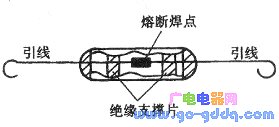Thermal fuses, commonly known as temperature fuses, are a temperature control component developed by the United States in the 1960s. The thermal fuse was originally developed to prevent the fuel injection pump motor of the jet engine from overheating. Install it in the machine, it can automatically cut off the power when the machine has abnormal temperature, to prevent the machine from overheating and causing fire. Nowadays, such thermal fuses have been widely used in electric appliances such as electric kettles, electric woks, electric heaters and the like.
The typical structure of a thermal fuse is shown in the figure below.

This type of fuse, which determines its melting point, is mainly the melted sheet of Figure 1, and different melting recipes are selected to obtain melting points at different temperatures.
The thermal fuses currently on the market have a relatively simple structure, and the fuse is the fusion solder joint between the two lead wires, as shown in the following figure.

Thermal fuses have three main parameters:
(1) Operating temperature: temperature at the time of melting:
(2) Tolerance: The melting fin formulation of each thermal fuse is somewhat different, the structural process will be slightly different, and the melting point consistency is difficult to achieve. Therefore, an error amount is called tolerance; usually the tolerance is 1.6 °C. ~1.85 ° C;
(3) Rated current and voltage: There is internal resistance in any conductor, and the internal resistance will generate heat when passing through the current. If the heat is generated to a certain extent, the fuse will be blown. Therefore, the fuse is marked with the rated current and voltage.
Single Phase Portable EV Charger
Single Phase Portable Ev Charger,Portable Electric Car Charger,Portable Electric Vehicle Charger,Portable Ev Car Charger
Yangzhou JERI New Energy Co., Ltd. , https://www.jrevcharging.com